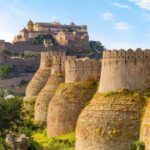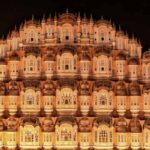5 Must-See Palaces Of Rajasthan, the “Land of Kings,” is famed for its breathtaking palaces, each a testament to the region’s rich history and architectural grandeur. Situated in the heart of Jaipur, the City Palace stands as a magnificent blend of Mughal and Rajput styles. This sprawling complex, still partially home to the royal family, houses museums showcasing textiles, weaponry, and art, offering a glimpse into Jaipur’s regal past.
A short journey from Jaipur leads to the Amer Palace, a UNESCO World Heritage site. Constructed of pink and yellow sandstone, this fort-palace is an architectural marvel. Its highlights include the Sheesh Mahal, adorned with intricate mirror work, and the serene Sukh Niwas. The experience of ascending to the palace on elephant back adds to its allure.
Dominating the Jodhpur skyline, the Mehrangarh Fort is a formidable structure perched atop a high hill. Its imposing walls enclose palaces like the Sheesh Mahal and Phool Mahal, each exhibiting exquisite craftsmanship. The fort museum provides a deeper understanding of the region’s history through its extensive collection of artifacts.
Udaipur’s City Palace, located on the picturesque banks of Lake Pichola, offers a captivating fusion of European, Mughal, and Chinese architectural influences. This “palace of palaces,” built over centuries, presents a mesmerizing view of the lake and houses attractions like the Peacock Courtyard and the women’s quarters, Zenana Mahal.
These palaces are not merely historical monuments; they are living embodiments of Rajasthan’s royal legacy, inviting visitors to immerse themselves in a world of opulence and architectural splendor.
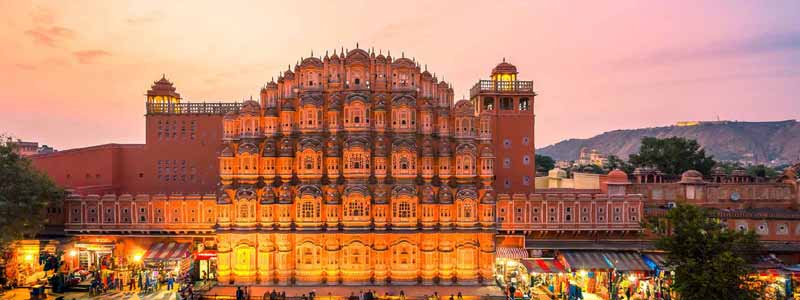
Jaipur – The Pink City
Jaipur, the capital of Rajasthan, is famously known as the “Pink City” due to the distinctive color of its buildings. This tradition dates back to 1876 when Maharaja Sawai Ram Singh I ordered the entire city to be painted pink in preparation for the visit of Prince Albert, the Prince of Wales. Pink was considered the color of hospitality, and the Maharaja wanted to make a good impression on the royal guest.
Even today, the pink hue dominates the cityscape, giving Jaipur a unique charm and making it a delight for photographers and visitors alike. The city was founded in 1727 by Maharaja Sawai Jai Singh II, a scholar and astronomer who meticulously planned the city’s layout based on Vastu Shastra principles. This makes Jaipur one of India’s first planned cities, with wide avenues and well-defined blocks.
Beyond its color, Jaipur is a treasure trove of historical and architectural wonders. The City Palace, located in the heart of the old city, is a sprawling complex of courtyards, gardens, and buildings that blend Rajput, Mughal, and European architectural styles. Hawa Mahal, or the “Palace of Winds,” with its intricate façade of 953 small windows, is another iconic landmark. Amer Fort, a magnificent palace complex perched on a hilltop, showcases a blend of Rajput and Mughal architecture and offers stunning views of the surrounding landscape, 5 Must-See Palaces Of Rajasthan.
Jaipur is also a vibrant hub of culture and commerce, known for its bustling bazaars, where you can find everything from traditional handicrafts and textiles to jewelry and gemstones. The city comes alive during festivals like Diwali and Teej, with colorful decorations, music, and dance performances.
With its rich history, stunning architecture, and vibrant culture, Jaipur offers a captivating glimpse into the royal heritage of Rajasthan and is a must-visit destination for any traveler to India.
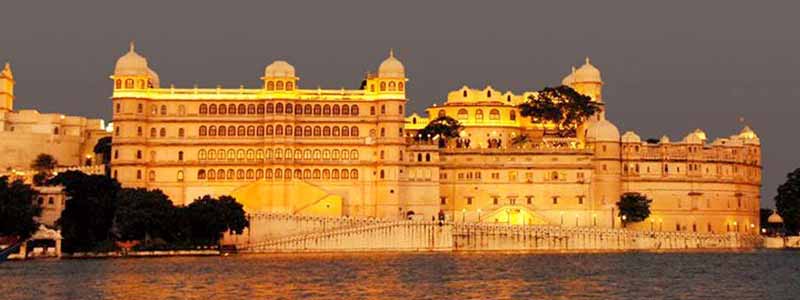
Udaipur – The City of Lakes
Udaipur, often called the “City of Lakes” or the “Venice of the East,” is a mesmerizing city in Rajasthan, India, renowned for its stunning lakes, majestic palaces, and vibrant history. Founded in 1559 by Maharana Udai Singh II, it served as the capital of the Mewar kingdom and is nestled amidst the Aravalli hills.
The city’s identity is intricately linked to its lakes. Pichola Lake, the oldest and perhaps most famous, is home to the iconic Lake Palace and Jag Mandir. Fateh Sagar Lake, another significant lake, offers boating and picturesque views. Other notable lakes include Udai Sagar Lake and Badi Lake, each adding to the city’s serene charm. These interconnected water bodies not only enhance Udaipur’s beauty but also play a crucial role in the region’s ecology and water supply.
Udaipur is not just about lakes; it’s a treasure trove of palaces and historical sites. The City Palace, a sprawling complex on the banks of Lake Pichola, showcases a blend of Rajput and Mughal architecture. Other must-visit palaces include the Lake Palace, now a luxurious hotel, and the Monsoon Palace, offering panoramic city views. Jagdish Temple, a fine example of Indo-Aryan architecture, and Bagore Ki Haveli, a historic mansion, are also key attractions, 5 Must-See Palaces Of Rajasthan.
Beyond the palaces and lakes, Udaipur offers a rich cultural experience with its bustling markets, traditional music and dance, and delicious Rajasthani cuisine. The city’s romantic ambiance, coupled with its historical significance, attracts visitors from all over the world.
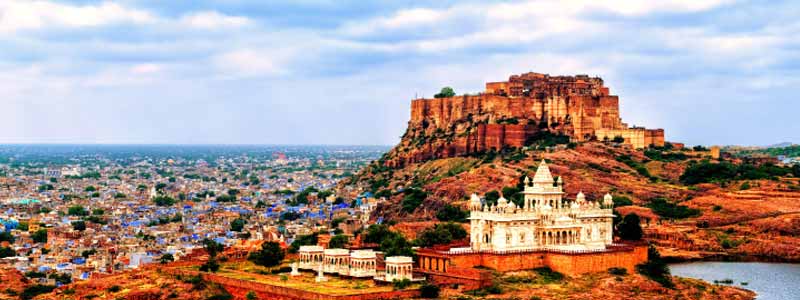
Jodhpur – The Blue City
Jodhpur, fondly known as the “Blue City,” is the second-largest city in Rajasthan. Founded in 1459 by Rao Jodha, a Rajput chief of the Rathore clan, it was historically the capital of the Marwar kingdom. The city’s nickname comes from the striking blue hue of its houses in the old city, a tradition with several possible origins. Some believe it was initially used by Brahmins to signify their high caste, while others suggest the blue paint helps keep the buildings cool in the desert heat or acts as an insect repellent.
Dominating the skyline is the majestic Mehrangarh Fort, one of the largest forts in India. Perched on a 400-foot high hill, it offers breathtaking panoramic views of the “Blue City.” Within its formidable walls lie intricately designed palaces like the Sheesh Mahal (Mirror Palace) and Phool Mahal (Flower Palace), along with a museum showcasing royal artifacts.
Beyond the fort, Jodhpur offers a wealth of attractions. The serene Jaswant Thada, a stunning white marble cenotaph, provides a tranquil contrast to the bustling city. The Umaid Bhawan Palace, a grand 20th-century palace, now serves as a heritage hotel and museum, offering a glimpse into royal life. The Clock Tower and the adjacent Sardar Market are vibrant hubs of activity, filled with the sights, sounds, and smells of local life.
Jodhpur’s strategic location on the historic trade route between Delhi and Gujarat contributed to its prosperity, particularly in the trade of opium, silk, and spices. Today, it remains a significant center for trade and tourism, attracting visitors with its historical charm, architectural grandeur, and unique blue landscape, 5 Must-See Palaces Of Rajasthan.
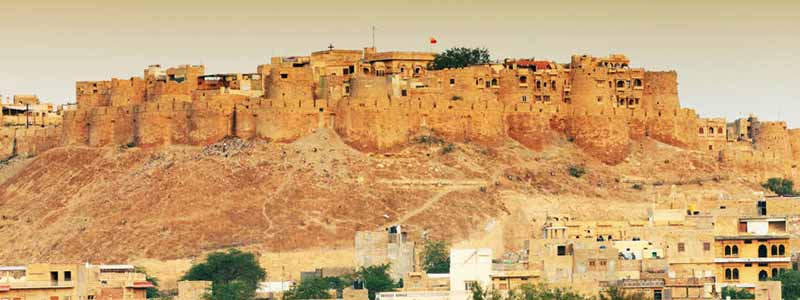
Jaisalmer – The Golden City
Jaisalmer, often called the “Golden City,” is a mesmerizing jewel nestled in the heart of the Thar Desert in Rajasthan, India. Its name is derived from the yellow sandstone used extensively in its architecture, which gives the city a magical golden hue, especially during sunset. Founded in 1156 by Rawal Jaisal, a Bhati Rajput ruler, Jaisalmer stands proudly on a ridge, crowned by the magnificent Jaisalmer Fort, a UNESCO World Heritage Site.
This living fort is a testament to the city’s rich history and cultural heritage. Within its walls, you’ll find palaces, intricate Jain temples dating back to the 12th and 16th centuries, and bustling markets. The fort’s strategic location on ancient trade routes between India, Central Asia, the Middle East, and North Africa contributed to its prosperity and cultural exchange.
Beyond the fort, Jaisalmer is adorned with stunning havelis, the elaborate mansions of wealthy merchants. Patwon ki Haveli and Salim Singh ki Haveli are prime examples of the city’s architectural grandeur, featuring intricate carvings and delicate latticework. The serene Gadisar Lake, built in the 14th century, offers a tranquil escape and a picturesque spot to witness the city’s golden reflection.
Jaisalmer’s culture is as vibrant as its architecture. The locals are known for their warm hospitality and colorful attire. Folk music and dance are integral to their traditions, with performances adding life to festivals and celebrations. The Desert Festival, held annually, showcases the region’s rich arts, crafts, music, and unique traditions, including camel races and turban-tying contests.
Despite its desert location, Jaisalmer has a unique charm that attracts visitors worldwide. The camel safaris into the surrounding sand dunes offer a quintessential desert experience, allowing travelers to immerse themselves in the stark beauty and tranquility of the Thar, 5 Must-See Palaces Of Rajasthan.
Jaisalmer, the Golden City, is more than just a historical site; it’s a living testament to the resilience, artistry, and vibrant culture of Rajasthan, offering a truly unforgettable experience.
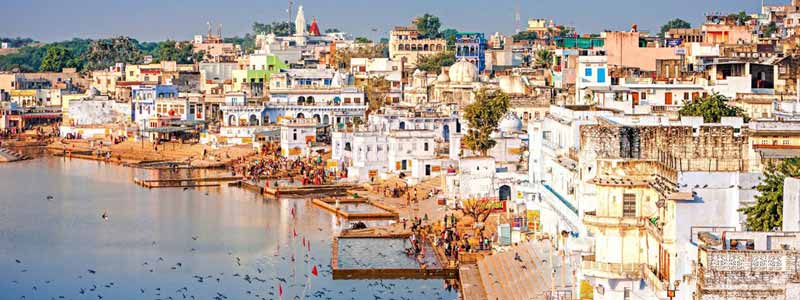
Pushkar – The Holy City
Pushkar, often called “Tirth Raj,” the king of pilgrimage sites, is a holy city nestled around the sacred Pushkar Lake in Rajasthan. Legend says Lord Brahma dropped a lotus flower, forming the lake’s holy waters. This act consecrated Pushkar, making it a significant pilgrimage destination for Hindus and Sikhs alike.
The town is steeped in religious significance, boasting hundreds of temples and 52 ghats surrounding the lake. The most famous is the 14th-century Brahma Temple, one of the few dedicated to Lord Brahma. Bathing in the lake, especially during Kartik Purnima, is believed to cleanse sins. The ghats buzz with devotees performing rituals, making offerings, and seeking spiritual purification.
Beyond its religious importance, Pushkar is known for its annual Camel Fair, a vibrant spectacle of livestock trading and cultural festivities. This week-long event attracts visitors worldwide, showcasing Rajasthani traditions through music, dance, and unique competitions like the “longest moustache” and camel races 5 Must-See Palaces Of Rajasthan.
The fair highlights the town’s unique blend of spirituality and rural charm. While the livestock trading remains central, the cultural performances and the sacred rituals at the lake create a mesmerizing experience. Pushkar offers a glimpse into the heart of Rajasthan, where tradition and faith intertwine.
Pushkar’s serene lake, ancient temples, and the lively Camel Fair make it a must-visit destination. It’s a place where you can immerse yourself in spiritual practices, witness colorful cultural traditions, and experience the unique charm of a holy city in Rajasthan.



